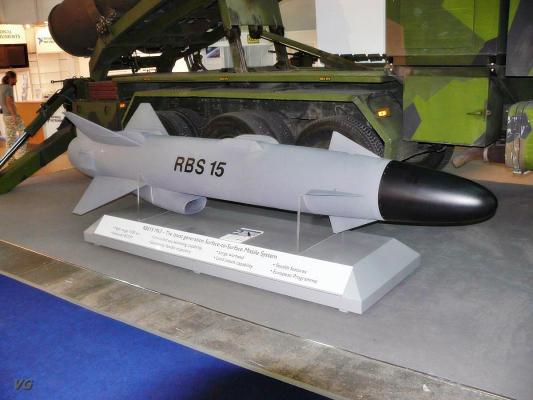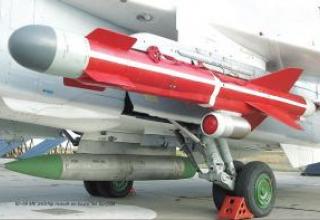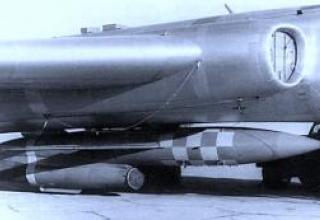The RBS15 Mk3 missile is designed to engage ships of major classes, including high-speed small ships, in the open sea, skerries, bases and near shore. The main carriers of the new missile will be missile boats, corvettes, frigates, aircraft, as well as stationary and mobile coastal defense systems.
The RBS15 Mk3 missile is a development of the RBS15 Mk2 missile. It uses the same combat unit, guidance methods and control software. However, RBS15 Mk3 has extended range, improved target detection capabilities and provides more effective penetration of the enemy's BMD due to reaching the target at extremely low altitudes, maneuvering by random law and increased engine thrust at the end of the trajectory.
The RBS15 Mk3 missile was developed by the Swedish company "Saab Bofors Dynamics".
The anti-ship complex with RBS15 Mk3 missile is part of the armament of Swedish corvette "Visby", Polish corvette of project 621 and perspective frigate of project F-125 of German Navy. It was announced about the Finnish Navy's rearmament program, which provides for replacement of previous versions of RBS15 with a new missile.
The missile was tested until 2007 at the Swedish Ministry of Defence's Widzel test site. In the course of the tests, the full cycle of RBS15Mk3 onboard systems was tested, including the interception planning system, checking the target detection capabilities of the CNS and manoeuvring the missile in the final trajectory section with high overloads. At the final stage of the RBS15Mk3 missile launches were carried out by an onboard missile battery. During one of the flights, the missile flew 165 km through 25 route turning points and was pre-programmed to "capture" two target ships (including a repeated attack) and one ground before hitting the final target - the ship.
Composition:
The RBS-15Mk3 rocket (see photo 1, photo 2) is arranged according to the aerodynamic scheme "duck" with cross-shaped arrangement of folding arms and wings (see the scheme). The power pack includes a turbojet engine "Microturbo TR60-5" with an adjustable thrust vector and two solid fuel starting accelerators. Small-sized single-shaft turbojet engine TR60-5, designed by French company Microturbo and equipped with a three-stage axial compressor. The TR60-5 develops static take-off thrust up to 4.4 kN. In addition to aviation kerosene JP8, the engine can run on synthetic high-calorie fuel JP10.
The thrust vector of the launch accelerators is inclined to the longitudinal axis of the missile at an angle of 18°. The RBS-15Mk3 has a maximum range of 200 km due to its larger capacity fuel tank and higher density fuel. According to the developer company in the future it is possible to increase the range up to 400 km.
In order to reduce the effective scattering area, the glider design provides for the wide use of radio absorbent materials, as well as the control of the angle of inclination of the CNS antenna mirror. Reduced infrared visibility is expected to be achieved by shielding the engine bay, which will reduce the value of the sheath radiation factor.
The missile's onboard equipment consists of an inertial control system, a new digital autopilot, an adaptive radio altimeter (tunable to the frequency depending on the state of the sea surface), a computer and a radar CNS. The missile is guided on a low-altitude march section of the trajectory by means of an inertial system with a radio altimeter, which ensures its flight to a target in a straight line or a programmed turning to a target at a predetermined point, as well as its flight over obstacles (islands). The control system allows for repeated search and attack when the target's capture is broken, as well as anti-aircraft manoeuvring in vertical and horizontal planes at the final point of the trajectory. It provides for the exchange of data between missile carriers and various sources of target designation, and coordination between coastal batteries, ships and aircraft.
The millimetre-range monopulse radar CNS with wide antenna aperture and aperture synthesis makes it possible to reliably distinguish sea targets against the shore.
A variant of equipment RBS-15Mk3 of combined radar and passive infrared homing head has been developed (see diagram). The use of the combined radar and passive infrared homing head dramatically increases its interference immunity and the probability of hitting the target in the conditions of strong radio electronic counteraction. In addition, a terrain guidance system is being developed for the missile and a NAVSTAR space radio navigation system receiver is being considered.
The missile is equipped with a 200 kg shrapnel-flash BC, which can be detonated both when hitting the target directly and from non-contact sensors.
The MEPS (Missile Engagement Planning System) automatic firing control system has a graphical user interface and allows to process data from various sources of target designation, develop a plan of fire, control prelaunch preparation and launch of missiles.
The system can operate in four main modes:
- combat;
- training;
- routine missile control and inspection;
- Tactical simulation mode.
MEPS allows for the calculation of the required number of missiles in the salvo, flight trajectories with the assignment of each PCR breeding and turning points in the horizontal plane and points of increase (decrease) of the trajectory in the vertical plane.
Characteristics:
| Range, km | 200 |
| The length of the rocket, mm | 4350 |
| The diameter of the rocket body, mm | 500 |
| Diameter with folded stabilizers, mm | 850 |
| Swing of stabilizers, mm | 1400 |
| Launch weight of the rocket without boosters, kg | 630 |
| Launch weight of the rocket with boosters, kg | 800 |
| Weight of combat unit, kg | 200 |
Testing:
As part of the UK's 12th Air Defence Regiment, Rapier SAMs participated in combat operations during the Falkland conflict in 1982. 12 launchers have been deployed since the first day of the English landing on the Falkland Islands. Sources from the English government (White Paper: The Falkland Campaign. Lessons) claim that 14 Argentine planes were destroyed by Rapier complexes. However, according to other information, the "Rapier" complex shot down only one AI Dogger A and participated in the destruction of the A-4C Skyhawk. The Blindfire radar did not participate in these hostilities.
The Rapier complex participated on the Iranian side in the war between Iran and Iraq in the 1970s, and is believed to have destroyed an Iraqi Tu-22 type bomber.
The "Rapier" SAM system was also deployed for the English multinational air defense contingent during Operation Desert Storm in 1991.












